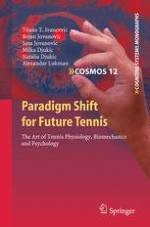The book “Paradigm Shift for Future Tennis” starts with revelations that make obvious the limitations of today’s tennis, which does not use the laws of modern Biomechanics and Neurophysiology. The second part of the book includes a new approach to the quantum mind of a champion. It will reveal the secret weapon of Roger Federer and the blueprint of a future tennis champion. This book will expose the new tennis shot emerging from the field of sports science. It is a real weapon, which can generate a ball-speed similar to that of the first serve: the Power High-Forehand. Its aim is to generate maximal possible racket-head speed while players do not wait for the ball to bounce. This is both a tactical and psychological basis for the future tennis game. This aggressive interceptive psychology will shape the minds of future tennis champions. High racket-head speed can be achieved using the stretch-reflex, without big loops and swings. Weapons of a future tennis game will comprise of whip-like tennis serves and ground strokes, based on the stretch–reflex, and using the whole body in a fluid and integrated manner, thus manifesting a superb combination of speed and strength. Restructure your brain and apply the power of state of the art biomechanical, mathematical, medical, neural, cognitive, and quantum computational intelligence to understand the tennis of today and the future!
